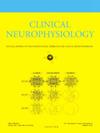Reliability of short interval cortical inhibition in children with attention deficit hyperactivity disorder
IF 3.7
3区 医学
Q1 CLINICAL NEUROLOGY
引用次数: 0
Abstract
Objective
Utility of biomarkers depends on test–retest consistency. Reduced Short Interval Cortical Inhibition (SICI) has emerged as a consistent finding in children with Attention Deficit Hyperactivity Disorder (ADHD); however, test–retest has not been established for children with ADHD. This is particularly crucial given that Transcranial Magnetic Stimulation (TMS) motor evoked potential (MEP)-based measures have high intra-subject variability and susceptibility to state-effects on motor cortex excitability. Addressing this, the objective of this study was to estimate test–retest reliability of paired-pulse SICI and of Intracortical Facilitation (ICF) in children, including those with ADHD and typically developing (TD) controls.
Methods
Sixty-four 8-to-12-year-old children (28 female; 35 ADHD; 29 TD) were recruited at two sites and SICI and ICF measured across two visits separated by 21 days. Intraclass correlations (ICCs) were calculated.
Results
Good reliability for SICI (ICC > 0.75), but only moderate for ICF (ICC > 0.50), was found among ADHD children, after accounting for test-pulse MEP amplitudes (>0.25 mV) and outliers.
Conclusions
These findings support the potential for SICI as a biomarker of ADHD in school-aged children.
Significance
This research addresses a critical gap in clinical neurophysiology, as estimating the reliability of SICI is needed to utilize it in interventional or longitudinal studies.
儿童注意缺陷多动障碍的短间隔皮质抑制的可靠性
目的生物标志物的有效性取决于复检一致性。减少短间隔皮质抑制(SICI)已成为儿童注意缺陷多动障碍(ADHD)的一致发现;然而,对于多动症儿童,测试-再测试尚未建立。考虑到基于经颅磁刺激(TMS)的运动诱发电位(MEP)测量具有高度的受试者内部变异性和对运动皮层兴奋性状态影响的易感性,这一点尤为重要。为了解决这个问题,本研究的目的是评估配对脉冲SICI和皮质内促进(ICF)在儿童中的测试-重测信度,包括ADHD和典型发展(TD)对照。方法64例8 ~ 12岁儿童(女性28例;35多动症;在两个地点招募了29名TD), SICI和ICF在相隔21天的两次访问中进行测量。计算类内相关性(ICCs)。结果SICI (ICC >;0.75),但对于ICF (ICC >;在考虑了测试脉冲MEP振幅(>0.25 mV)和异常值后,ADHD儿童中发现了0.50)。结论这些发现支持SICI作为学龄儿童ADHD的生物标志物的潜力。本研究解决了临床神经生理学的一个关键空白,因为需要估计SICI的可靠性,以便在介入性或纵向研究中使用它。
本文章由计算机程序翻译,如有差异,请以英文原文为准。
求助全文
约1分钟内获得全文
求助全文
来源期刊

Clinical Neurophysiology
医学-临床神经学
CiteScore
8.70
自引率
6.40%
发文量
932
审稿时长
59 days
期刊介绍:
As of January 1999, The journal Electroencephalography and Clinical Neurophysiology, and its two sections Electromyography and Motor Control and Evoked Potentials have amalgamated to become this journal - Clinical Neurophysiology.
Clinical Neurophysiology is the official journal of the International Federation of Clinical Neurophysiology, the Brazilian Society of Clinical Neurophysiology, the Czech Society of Clinical Neurophysiology, the Italian Clinical Neurophysiology Society and the International Society of Intraoperative Neurophysiology.The journal is dedicated to fostering research and disseminating information on all aspects of both normal and abnormal functioning of the nervous system. The key aim of the publication is to disseminate scholarly reports on the pathophysiology underlying diseases of the central and peripheral nervous system of human patients. Clinical trials that use neurophysiological measures to document change are encouraged, as are manuscripts reporting data on integrated neuroimaging of central nervous function including, but not limited to, functional MRI, MEG, EEG, PET and other neuroimaging modalities.
 求助内容:
求助内容: 应助结果提醒方式:
应助结果提醒方式:


